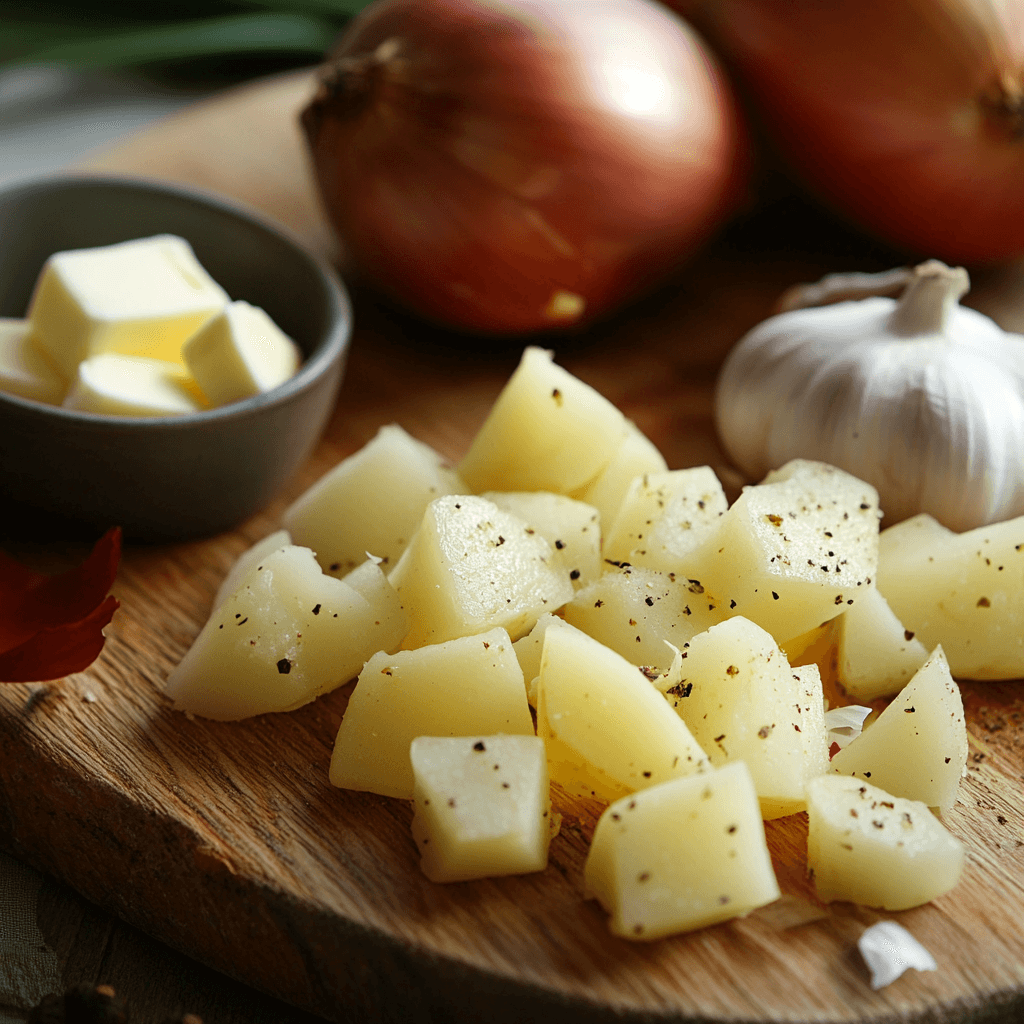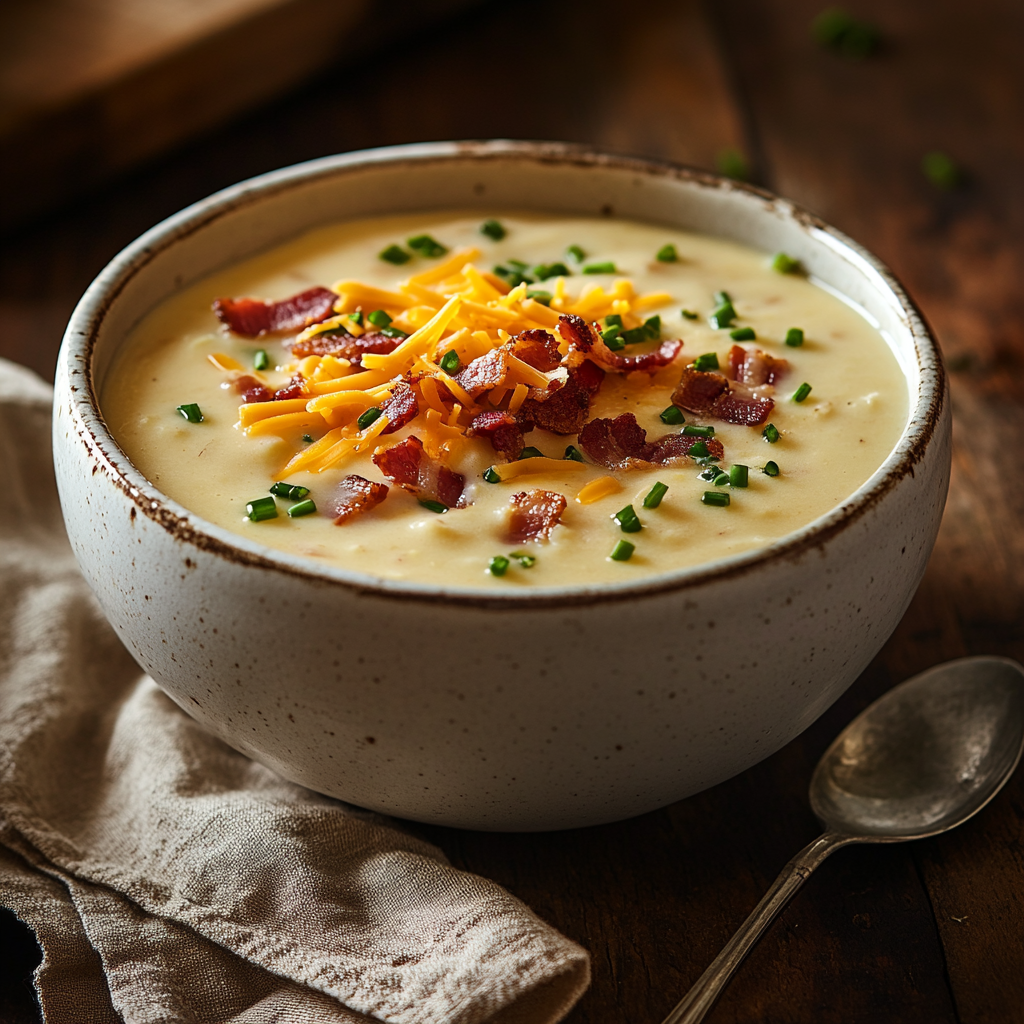There’s something undeniably comforting about a warm, creamy bowl of potato soup. Whether it’s a chilly evening or you’re simply craving something hearty, potato soup stands as the ultimate comfort food. This article is your go-to guide for crafting the perfect potato soup—from selecting the best ingredients to mastering classic and creative recipes. We’ll explore popular variations, expert tips for thickening, delicious toppings, and much more. By the end of this guide, you’ll be ready to whip up a batch of rich, savory potato soup that will warm both hearts and stomachs.
Table of Contents
Introduction to Potato Soup
History and Origins of Potato Soup
Potato soup has humble beginnings, rooted in the rich traditions of European comfort food. Potatoes, native to South America, became a dietary staple across Europe by the 16th century, thanks to their affordability and versatility. Over time, many cultures developed their own versions of potato soup, blending local ingredients and cooking methods. The Irish are known for their thick, rustic potato soups, while French cuisine introduced more refined versions like vichyssoise—a chilled, creamy potato and leek soup. This global evolution showcases how this simple dish adapts to different tastes and traditions.
Why Potato Soup is a Comfort Food Staple
What makes potato soup so beloved? Its creamy texture and rich flavor offer a warm hug in a bowl. Potatoes naturally create a thick, velvety base, pairing perfectly with ingredients like bacon, cheese, and fresh herbs. Plus, it’s incredibly customizable—whether you prefer it chunky or smooth, vegetarian or loaded with toppings. Its simplicity and heartiness make it a go-to dish for family gatherings, cozy nights in, or even meal prepping for busy weeks. There’s just something magical about a spoonful of steaming, buttery potato soup that feels like home.
Essential Ingredients for the Perfect Potato Soup
Creating the perfect potato soup begins with choosing the right ingredients. Each component plays a crucial role in crafting a rich, creamy, and flavorful bowl that satisfies every craving. Let’s break down the must-have ingredients for this comfort food classic.
Choosing the Best Potatoes for Potato Soup
The star of the show is, of course, the potato. But not all potatoes are created equal when it comes to soup. For a creamy, melt-in-your-mouth texture, Russet potatoes are a top choice. Their high starch content allows them to break down beautifully during cooking, giving the soup a velvety finish. Alternatively, Yukon Gold potatoes offer a naturally buttery flavor and hold their shape well if you prefer a chunkier soup.
For those looking for a healthier twist, consider sweet potatoes. They add a subtle sweetness and a vibrant color, making the soup both nutritious and visually appealing. Whichever variety you choose, the key is using fresh, firm potatoes for the best results.
Key Ingredients: Broths, Creams, and Seasonings
Once you’ve selected your potatoes, it’s time to build flavor. A good potato soup starts with a rich broth. Chicken broth is commonly used for its savory depth, but vegetable broth works well for a vegetarian option. For an extra layer of flavor, adding a bit of bacon grease or butter when sautéing onions and garlic can elevate the soup’s richness.
Creaminess is essential. Heavy cream, half-and-half, or even sour cream can give the soup a luscious texture. For a lighter version, milk or plant-based alternatives like almond or oat milk are great substitutes.
Seasonings tie everything together. Classic spices like salt, black pepper, and garlic powder are must-haves, while herbs such as thyme, rosemary, and parsley add aromatic notes. A touch of smoked paprika or cayenne pepper can introduce a subtle heat for those who like a little kick.
For more cozy recipe ideas, check out this Pumpkin Banana Loaf—another warm, comforting treat perfect for fall!
Classic Potato Soup Recipe
Ready to make a bowl of the most comforting potato soup? Follow this step-by-step guide for a rich, creamy, and utterly satisfying dish.
Step-by-Step Cooking Instructions

Ingredients:
- 5 large Russet potatoes, peeled and diced
- 1 medium onion, finely chopped
- 3 cloves garlic, minced
- 4 cups chicken broth (or vegetable broth)
- 1 cup heavy cream
- 4 slices bacon, cooked and crumbled
- 2 tbsp butter
- Salt and pepper to taste
- Optional: shredded Cheddar cheese, chives, or green onions for topping
Instructions:
- Cook the Bacon:
In a large pot or Dutch oven, cook the bacon over medium heat until crispy. Remove and set aside, leaving about 1 tablespoon of bacon grease in the pot for extra flavor. - Sauté the Vegetables:
Add butter to the pot. Once melted, sauté the onions and garlic until fragrant and translucent. This builds a rich, savory base for your soup. - Add the Potatoes and Broth:
Stir in the diced potatoes, coating them with the onion and garlic mixture. Pour in the broth, bring to a boil, then reduce the heat and let it simmer for about 20 minutes or until the potatoes are fork-tender. - Blend for Creaminess:
For a creamier texture, transfer half of the soup to a blender and puree until smooth. Return it to the pot and stir to combine. - Add the Cream and Seasonings:
Stir in the heavy cream and season with salt and pepper to taste. Let it simmer for another 5 minutes to meld the flavors. - Top and Serve:
Ladle the soup into bowls and top with crumbled bacon, shredded Cheddar cheese, and chopped chives or green onions.
Tips for Achieving a Creamy and Rich Texture
- Use Starchy Potatoes: Russet potatoes naturally break down and thicken the soup.
- Don’t Skip the Bacon Grease: It adds a smoky depth of flavor.
- Blend Partially: Blending only half the soup keeps it creamy yet chunky.
- Add a Roux: For extra thickness, make a roux by cooking equal parts butter and flour, then stir it into the soup.
With this classic recipe, you’ll have a bowl of potato soup that’s as comforting as it is delicious. Ready to explore more flavors? Stay tuned for Part 4: Popular Potato Soup Variations!
Popular Potato Soup Variations
While the classic potato soup is undeniably delicious, there’s no harm in mixing things up! With a few simple tweaks and creative ingredient swaps, you can transform this traditional dish into exciting new versions that cater to different tastes and dietary needs. Let’s explore some of the most popular variations of this cozy comfort food.
Loaded Baked Potato Soup
Love baked potatoes loaded with all the fixings? Then you’ll adore Loaded Baked Potato Soup! This indulgent version takes the best parts of a baked potato—crispy bacon, melted cheese, sour cream, and chives—and combines them into a rich, creamy soup.
How to Make It:
- Use Russet potatoes for a fluffy texture.
- Stir in sour cream and sharp Cheddar cheese for extra creaminess.
- Top with crispy bacon bits, green onions, and an extra sprinkle of cheese.
Every spoonful feels like a bite of your favorite comfort food!
Vegan and Dairy-Free Potato Soup Alternatives
For those who are vegan or lactose intolerant, don’t worry—potato soup can still be incredibly creamy and flavorful! By using plant-based ingredients, you can enjoy all the comfort without the dairy.
Simple Swaps:
- Use vegetable broth instead of chicken broth.
- Replace heavy cream with coconut milk or cashew cream for a rich texture.
- Add nutritional yeast for a subtle, cheesy flavor.
A sprinkle of fresh herbs or crispy roasted chickpeas on top can add a satisfying crunch!
Chunky vs. Creamy Potato Soup
Some people love a silky-smooth soup, while others crave a heartier, chunkier texture. The good news? You can easily tailor your potato soup to your texture preference.
- For Creamy Soup: Blend most of the soup until smooth and velvety.
- For Chunky Soup: Only blend a small portion, leaving plenty of potato chunks.
Both styles are equally delicious and satisfying, so why not try both?
Techniques to Thicken Potato Soup
There’s nothing worse than a potato soup that turns out thin and watery. Luckily, there are several foolproof ways to achieve that thick, creamy consistency that makes this dish so comforting.
Using Roux, Cream, and Pureed Potatoes
A classic method for thickening soups is making a roux. This involves cooking equal parts butter and flour together until golden, then stirring it into the soup. This not only thickens the soup but also adds a rich, buttery flavor.
Another option is blending some of the cooked potatoes directly into the soup. This technique naturally thickens the broth while keeping the flavor true to its roots. Adding a splash of heavy cream or half-and-half can also create a luxurious texture.
Alternative Thickeners: Cornstarch, Flour, and Instant Potato Flakes
If you’re looking for quick and easy thickening solutions, several pantry staples can save the day:
- Cornstarch Slurry: Mix 1 tablespoon of cornstarch with 2 tablespoons of water, then slowly stir it into the soup. Let it simmer to activate the thickening power.
- All-Purpose Flour: Whisk a tablespoon of flour into a bit of broth before adding it back to the soup to prevent lumps.
- Instant Potato Flakes: Stirring in a small amount of instant potato flakes can quickly thicken the soup while keeping the potato flavor intact.
Each of these methods offers a simple, effective way to transform your soup from thin to thick and creamy.
Creative Toppings and Sides for Potato Soup
A warm bowl of potato soup is undeniably comforting on its own, but the right toppings and sides can elevate it from simple to sensational. Adding a variety of textures and flavors not only enhances the dish but also allows for endless customization. Let’s explore some of the best ways to serve and enjoy your potato soup.
Best Toppings: Bacon, Cheese, and Chives

Toppings are where you can truly make your potato soup your own. Whether you love bold flavors or something more subtle, the right finishing touches can transform every bite.
- Crispy Bacon: Nothing pairs better with creamy soup than crunchy, smoky bacon. Crumble it on top for a savory crunch.
- Shredded Cheddar Cheese: A generous sprinkle of sharp Cheddar melts beautifully into the soup, adding rich flavor.
- Fresh Chives or Green Onions: Their fresh, mild onion taste cuts through the richness, offering a bright contrast.
- Sour Cream or Greek Yogurt: A dollop of sour cream or thick Greek yogurt adds a tangy twist and extra creaminess.
- Croutons or Toasted Bread Crumbs: For extra crunch, toss in some buttery croutons or sprinkle toasted bread crumbs on top.
These toppings not only make the soup more filling but also create layers of flavor and texture.
Perfect Pairings: Breads, Salads, and More
Potato soup pairs wonderfully with a variety of sides, turning it into a complete and satisfying meal.
- Crusty Bread or Garlic Bread: Warm, crusty bread is perfect for dipping into the soup. Garlic bread adds a savory punch.
- Grilled Cheese Sandwich: A gooey grilled cheese sandwich is the ultimate comfort food pairing.
- Fresh Green Salad: Balance out the richness of the soup with a light, crisp salad topped with a zesty vinaigrette.
- Sweet Cornbread: A slightly sweet cornbread offers a delightful contrast to the savory flavors of the soup.
- Roasted Vegetables: Oven-roasted veggies like carrots, Brussels sprouts, or asparagus add a healthy, flavorful side.
Combining these sides with your potato soup will create a well-rounded and delicious meal that’s perfect for any occasion.
Storing and Reheating Potato Soup
If you find yourself with leftovers (though it’s hard to imagine!), knowing how to properly store and reheat potato soup ensures that every bowl tastes just as good as the first. With the right steps, you can enjoy this cozy dish for days.
Proper Storage Methods
To keep your potato soup fresh and flavorful, follow these simple storage tips:
- Cool Before Storing: Let the soup cool completely at room temperature. Storing hot soup can create condensation, leading to watery leftovers.
- Airtight Containers: Transfer the cooled soup to airtight containers to maintain freshness and prevent odors from seeping in.
- Refrigeration: Store the soup in the refrigerator for up to 4 days.
- Portion for Easy Reheating: Divide the soup into smaller containers for convenient single servings.
Can You Freeze Potato Soup?
Freezing potato soup can be tricky due to its creamy texture. Potatoes and dairy don’t always thaw well, often resulting in a grainy or separated consistency. However, it’s still possible with a few adjustments:
- Freeze Before Adding Dairy: If you plan to freeze the soup, hold off on adding cream or milk until reheating.
- Use Freezer-Safe Bags: Pour cooled soup into freezer bags, lay them flat, and freeze for up to 3 months.
- Thaw Gradually: Defrost in the refrigerator overnight before reheating.
- Stir Well When Reheating: To restore the creamy texture, stir in fresh cream or milk as it warms.
Frequently Asked Questions (FAQs)
Everyone has questions when it comes to making the perfect potato soup. From choosing the right thickener to exploring famous soups, here are answers to some of the most common queries.
What is the Best Thickener for Potato Soup?
The best thickener for potato soup largely depends on your desired texture. For a naturally creamy and hearty soup, blending some of the cooked potatoes directly into the broth works wonders. If you need extra thickness, a roux made of butter and flour adds both body and richness. Alternatively, mixing a cornstarch slurry or stirring in instant potato flakes can quickly thicken your soup without altering the flavor.
What Was Julia Child’s Favorite Soup?
Julia Child, the beloved culinary icon, was known for her love of traditional French cuisine. While she didn’t specifically highlight potato soup, she was famous for her version of potato leek soup (Potage Parmentier), a classic French dish combining potatoes, leeks, and cream. This soup is a close cousin to the modern creamy potato soup and offers a more delicate, refined flavor.
What is the Best Soup Dish in the World?
Though it’s hard to crown a single soup as the best in the world, many would argue that potato soup ranks high for its versatility and comfort factor. Globally, other popular soups include Pho from Vietnam, Tom Yum from Thailand, and French Onion Soup from France. However, when it comes to pure, cozy comfort, few soups compare to a warm bowl of homemade potato soup.
Do You Need to Cook Potatoes Before Putting Them in Soup?
No, you don’t need to cook potatoes beforehand when making potato soup. In fact, adding raw diced potatoes directly to the broth allows them to absorb flavors as they cook, enhancing the soup’s taste. Just be sure to simmer the soup until the potatoes are fork-tender, which usually takes about 20 minutes. If you’re short on time, using pre-boiled potatoes can speed things up, but cooking them in the soup is best for full flavor.
For more cozy recipe ideas, check out this Hawaiian banana bread —another warm, comforting treat perfect for fall!
Conclusion
Making the perfect bowl of potato soup is easier than you might think. From selecting the best ingredients to mastering different thickening techniques and exploring delicious variations, the possibilities are endless. Whether you prefer it rich and creamy, chunky and hearty, or fully loaded with toppings, potato soup is a timeless comfort food that can be customized to suit any taste.
Don’t be afraid to experiment with flavors, add your favorite toppings, or even create your own signature version. With the right ingredients and a little creativity, every bowl of potato soup can be a warm, satisfying hug in a bowl.
So grab your pot, chop those potatoes, and let the delicious journey begin!
Would you like help with any additional recipes or cooking tips?

